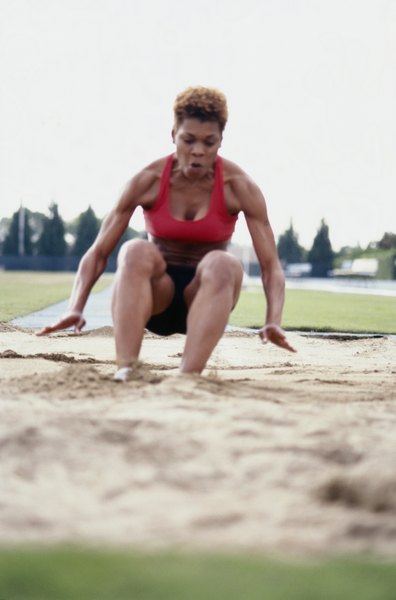The Best Techniques on How to Do the Standing Long Jump

The standing long jump or broad jump is a standard test of fitness. The jump provides an excellent way to measure your explosive leg strength. But if you only stride up to the line and jump, you won't score as well as you would with some attention to your technique. Improve your jumps with some basic techniques that harness the power of your legs and enable a fabulous jump, proving how fit you really are.
Get Ready
You don't run on the approach to a standing long jump, you start from a complete stop. To complete a standing long jump, place both feet parallel to the line and then leap forward. No steps backward or preparatory hops are allowed. To harness the power of your legs, squat deeply onto your heels while bringing your arms back. While you can't step into the jump, you can rock back onto your heels and forward onto your toes. Complete a couple of deep squats as you swing your arms back and your weight shifts to your heels, then rock forward and come up onto your toes as you straighten your legs and swing your arms forward.
Explode Forward
After a few preparatory squats to get your rhythm, begin your jump. As you shift your weight forward, keep your gaze straight ahead — not down on your landing spot. Throw your arms out in front of you and up, but stop your hands just past shoulder height. At the same time, explode into your jump by extending your hips, knees and ankles almost simultaneously.
Feet in Front
Squeeze the most distance out of your jump by throwing your feet forward just before you land. You can achieve this by whipping your arms back past your hips at your landing. Your feet will compensate by thrusting out in front. Take care not to get your feet too far forward so that you topple backward upon landing, as the distance you jump is marked by where you land -- and you don't want that mark to be your butt. As your feet hit the ground, absorb the shock by sinking into your feet while bending your legs at the hips and knees.
The Proper Focus
Once you've mastered these techniques, redirect your focus before you jump. According to a study published in the July 2010 "Journal of Strength and Conditioning Research," jumpers who focused externally on how far past the line they could jump performed much better than they did when they focused internally on their form. After some practice to get your rhythm and technique down, clear your mind of the details and imagine leaving that starting line far behind.
References
Resources
Writer Bio
John Hastings has written and edited health, fitness and science stories for magazines, websites and iPad publications. He has held senior editorial positions at "O, The Oprah Magazine," "Reader’s Digest" and "Health." He has also contributed to magazines such as "Men’s Journal" and "Bon Appetit."
